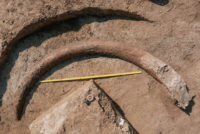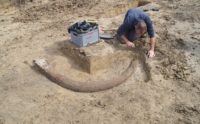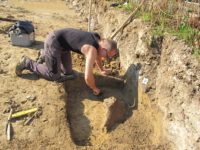 Archaeologists have discovered an impressively large mammoth tusk in the Bavarian town of Riekofen. The team was expecting to find remains of the 15th century town so the discovery of mammoth remains from the Ice Age came as a surprise. The tusk has yet to be radiocarbon dated, but mammoths went extinct in what is now Bavaria about 20,000 years ago.
Archaeologists have discovered an impressively large mammoth tusk in the Bavarian town of Riekofen. The team was expecting to find remains of the 15th century town so the discovery of mammoth remains from the Ice Age came as a surprise. The tusk has yet to be radiocarbon dated, but mammoths went extinct in what is now Bavaria about 20,000 years ago.
At a length of eight feet, the tusk still includes the tip tooth. Its size indicates it likely belonged to an adult bull. Mammoth bones are not uncommon finds, but nearly complete tusks of significant length are extremely rare. Another mammoth relic was found right next to the tusk. It’s a bone about one foot by two feet in dimensions probably also from a mammoth. It is not known right now whether it came from the same animal as the tusk.
 Dr. Christoph Steinmann, archaeologist with the Bavarian State Office for the Preservation of Monuments, thinks the tusk and bone were underwater for some time, which helped preserve them. There used to be a bend in the Danube in this area, and the thick, wet soil applied constant pressure to the external layers of the tooth. Even when the dentin forming the structure inside the tusk cracked and fell apart, the outer layers remained intact. Had they been in dry soil and exposed to air, they would have disintegrated.
Dr. Christoph Steinmann, archaeologist with the Bavarian State Office for the Preservation of Monuments, thinks the tusk and bone were underwater for some time, which helped preserve them. There used to be a bend in the Danube in this area, and the thick, wet soil applied constant pressure to the external layers of the tooth. Even when the dentin forming the structure inside the tusk cracked and fell apart, the outer layers remained intact. Had they been in dry soil and exposed to air, they would have disintegrated.
 To prevent this dangerous exposure, paleontologists coated the tusk with plaster strips, ensuring it could be lifted whole without any loss of bone material. Conservators with the State Office of the Preservation of Monuments will remove the moisture from the tusk gradually over the course of the next year or two (either freeze-drying or PEG, I’d guess). Once it is stabilized, it will go on display in the museum.
To prevent this dangerous exposure, paleontologists coated the tusk with plaster strips, ensuring it could be lifted whole without any loss of bone material. Conservators with the State Office of the Preservation of Monuments will remove the moisture from the tusk gradually over the course of the next year or two (either freeze-drying or PEG, I’d guess). Once it is stabilized, it will go on display in the museum.
The team did find what it was originally looking for, by the way. They discovered a well, rubbish pits, an oven, potsherds and the remains of a Grubenhäuser, a pit-house or sunken featured domestic dwelling, from the Medieval village.
Interesting note from the press release. In Bavaria archaeological excavations abide by the same safe distance regulations that govern construction sites, so digs are continuing in Germany, which has an atypically low rate of coronavirus deaths, when they’ve been shut down as non-essential in so many other countries.